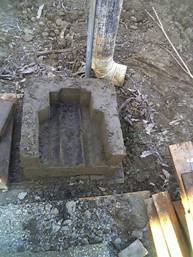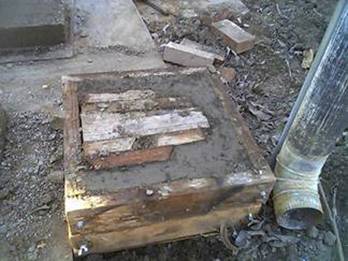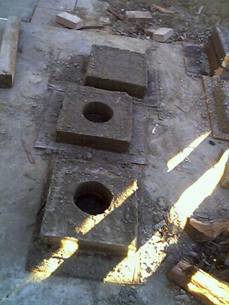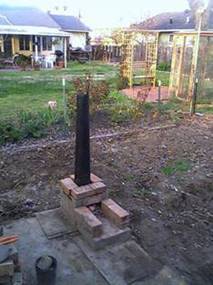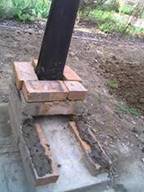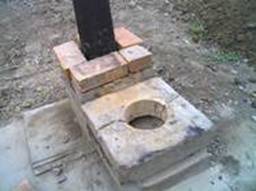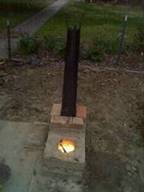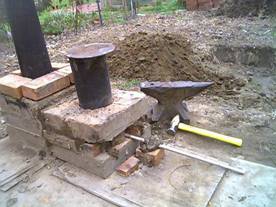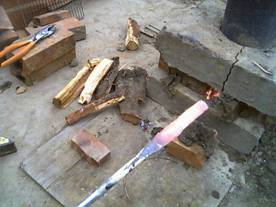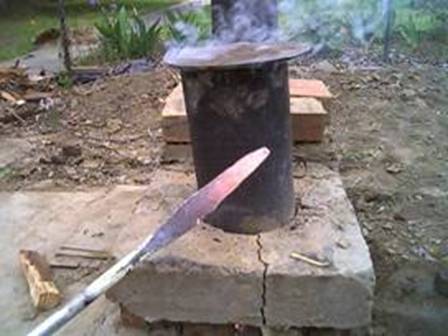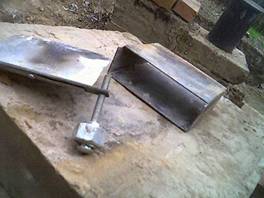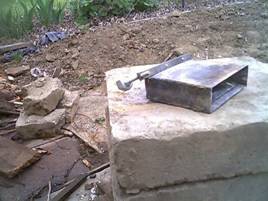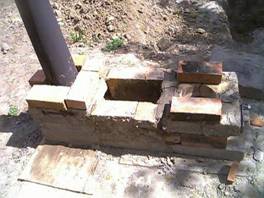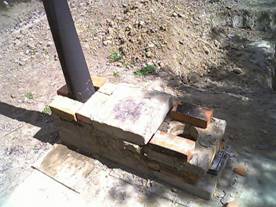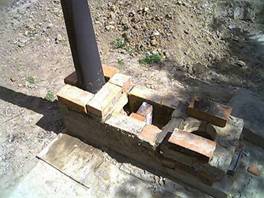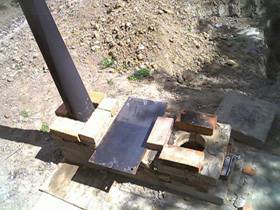Rammed
Earth Stove
The family has been
huddling around the “three-stone” fire for thousands of
years. Their food sources have changed some, and so have the
materials used for the room they live in, but the fire that warms
them, and the smoke that shortens their lives by decades, has been
with them for longer than memory. The simplest tools or household
items are treasures of great importance.
This minimum standard
of survival remains the same for millions in the world today. Most of
the victims of this trap are neither lazy nor stupid, but what can
you do with life if all you have are fire dirt, and barely enough
food to survive?
This exercise begins
with fire and dirt, and develops a technology path that leads towards
modern levels of convenience and health. The tricky part of this is
that the path must begin in a manner that is acceptable to such
cultures and must be sustainable locally without a continual supply
of outside help.
Over 40% of the energy available in
wood is in the form of smoke. By burning this smoke we create
healthier living conditions, and also increase the efficiency of the
fire (reducing the amount of wood needed). These advantages could be
invested in developing further advantages.
This project has been
further developed to demonstrate minimal blacksmithing capabilities,
and the addition of a small kiln for ceramics and other thermal
processes. These in themselves are not impressive, but they do
empower the poorest of households to repair and produce products that
they would otherwise have to buy.
Fire and future
The ability to
harness fire is one of the defining advantages that separate mankind
from animals. The sophistication with which fire is controlled and
applied continues to relate to the levels of comfort and empowerment
among humankind into our present time.
Historically, when
the use of fire was extended beyond comfort and food preparation,
those able to form tools and weapons of bronze and iron were able to
outlast and conquer those who could not. Controlling specialized
fuels enabled the Chinese to produce explosives and rockets. By
harnessing fire to propel cannon balls, Napoleon made city walls
obsolete.
Building on cannon
technology, cylinders were bored for the steam-driven pistons that
powered the industrial revolution. Internal combustion engines and
steam turbines now power our infrastructures.
Not all the world enjoys such benefits.
Millions of impoverished people are barely able to warm themselves or
cook their food. Many of them pay a heavy price health-wise -- losing
decades of their life expectancies due to the continual inhalation of
smoke within their dwellings. The inefficiencies of their
“three-stone” fireplaces waste much of the precious fuel
in the form of the smoke that fills their lungs and homes
The poverty and
scarcity of fuel in many areas makes it difficult to purchase simple
pottery, or to forge tools for agriculture and other applications.
There is also the case of areas that
have been devastated by war or natural disasters. The once-comforting
infrastructures have broken down and no one in town knows how to put
them together again.
Unavoidably, the
remaining primitive cultures are being devoured by the crowding, and
mobility of our modern world. The preservation of the ancient crafts
and cultural histories is an important concern, but such must be
preserved through other means than that of denying that the world is
shrinking.
A proactive approach of empowering
primitive lifestyles with greater levels of health and comfort will
do far more to preserve them than allowing them to dissipate into the
slums of sprawling cities through the lure of temporary jobs.
Designing a solution
The most productive
approach to design is to begin with the question “What do you
want?” When you begin by worrying about whether each proposed
detail is possible or economically feasible, etc., you never begin.
We need a fire-based
technology that will
Be acceptable – indeed
attractive – to those within the target lifestyle
Require a minimum of steel or
manufactured components
Be capable of evolving to where it
could provide a variety of cottage-industrial services such as:
(a) The firing of clay for
· Pottery
· Roof tiles
· Floor tiles
· Bricks
· Cylindrical tiles for vents,
drains, and water-courses
· Various tools and implements
· Art
(b) Blacksmithing
(c) Preparation of cement and plaster bases from bones, limestone, or
other minerals
(d) Perhaps at some point, power simple engines for shop use, or the
production of electricity
Utilize as much of the fuel’s
energy as possible
Consume and convert all the smoke
into energy
Minimize the release of fly-ash
Motivate the users to plant trees
to insure a continuing supply of fuel.
Goal -- Requires a minimum of
manufactured materials:
The primary material
used was earth dug up from a few feet away. It was mixed dry with
about 5-10% cement, and moistened just enough so it could be packed
together into firm clods. It was then packed firmly into oiled 2X4
frames by beating it first with a brick, and then a 3-lb hammer, and
then it was allowed to dry. This is an unsophisticated form of
“rammed earth”. The cement could be eliminated in cases
where the components would be fired or protected by a coating of
plaster. Every soil is different of course, so experimentation would
be required locally to assess proportions, drying times, strength,
etc.
These frames were 14”
square, and sometimes fitted with special plugs to create various
features. The frames were held together with bolts, so they could be
dismantled easily without disturbing the curing mud, and in some
cases they were stacked two-deep to create more specialized forms.
The critical
compromise in this material is the proportion of cement. Cement
returns to its anhydrous state when subjected to high temperatures,
and loses all strength – sometimes exploding in the process.
When subjected to high (red hot and above) temperatures, the earth
itself begins to fire into material that will not be dissolved by
water.
The outer portions
will never achieve such temperatures however, so they depend upon
just enough cement to prevent the rain from eroding them. Bottom
line: Use some cement, but as little as you can get away with.
In the photo
illustrating the “barbecue” stage, commercial bricks were
used because they could be conveniently reconfigured. In actual
practice, hardened or fired mud bricks would serve every bit as well.
As you see commercial bricks in some of the other photos to come,
think “mud”. In the case of any such components, always
fill all the cracks between with mud so that the only drafts are the
ones you’ve intended.
The stack is of
course sheet metal, and it was made to taper from 6” at the
base to 4” at the top. You could probably build one out of mud,
but so far I haven’t needed to.
Goal – Acceptability:
I know of a situation
where volunteers actually built vented stoves in single-room
dwellings to protect the occupants from smoke. There were clearly
reservations among many of the recipients.
These people were
accustomed to the instant radiated warmth of an open fire. I am sure
that it was also obvious that all that nice warm smoke was being
drawn up the chimney – indeed, even the best of high-tech
woodstoves seldom leave more than about 60% of the wood’s
energy indoors, and traditional masonry fire places never leave no
more than about 20% under the best of circumstances (only when the
fire is large).
The barbecue
This system begins
with no more than a smokestack with a simple barbecue attached.
Admittedly this is not real exciting, but there are a few things to
be said for it.
· Most importantly, it is the first
step on a path to a real solution. It would be helpful from an
acceptance standpoint if potential users had a chance to see a
fully-developed system, along with samples of the products it could
produce.
· The stack, though only three feet
tall, draws the smoke out of the user’s face and into their
hair. The stack is tapered to increase the draw, as well as for
stability.
· The draft caused by the stack
seems to concentrate the fire enough to burn more of the smoke than
is burned by the more random drifting of an open fire, although not
always all of it. More energy is derived, and less smoke is produced.
· The exhaust heat which at this
point would normally rise directly towards the ceiling as it seeks
its exit, now warms the stack, causing it to radiate heat into all
visible parts of the room.
· On the first system I built, I
provided pedestals for mounting a pot or plate on top of the stack to
scavenge the flue heat. As it turned out, there really wasn't enough
heat escaping up the stack to do much good.
· A certain amount of heat remains
stored in the masonry long after the fire is out, and we all know
that there is nothing more cuddly than a nice warm block of dried
mud.
· The open radiant fire is still
there – point one of the rejection goes away.
· At least the heat of what was the
smoke stays in the room – scratch point two. Point two should
be negotiated though, because there are still things that can kill
you even in the invisible gasses – especially if you didn’t
have leaky walls and a tile or thatched roof.
Before leaving this
“barbecue” phase, let’s exploit the technology
potential just a little further.
During each cooking session, it would
be possible to fire the face of a well-dried brick or two by building
the fire directly on them. This could also work for simple tiles, and
perhaps a few other shapes. Some additional work might be
performed by packing items along the sides of the fire. The objects
could then be turned to expose another face for the next session.
Consider also the
reduction of bones, limestone, and other minerals for the preparation
of plasters and cements. We are obviously talking small quantities
here, but with a few months of almost normal living, such resources
would begin to add up. The energy required in this case, would cost
almost nothing.
In another section
you will see a chamber capable of firing clay. This chamber would
also be suitable for the reduction of bones, limestone, and other
minerals, so that they may be ground up for plasters and cement.
The forge
The next phase of
fire-control begins when we cover the brick trench with something
like a mud toilet seat – potty train the kids somewhere else
please, or they’ll never get the hang of it.
You can still see the
fire, but by controlling the air and fuel from both the top and the
front, you can begin to develop some pretty fierce temperatures. It
would also be good to increase the height of the stack to at least 8
or 10 feet. This will provide a more powerful draft to intensify the
fire (further reducing the emissions), and safely vent any unburned
exhaust to your neighbor’s lungs.
Eliminating smoke
If you stand wood on
end in a short tube inserted in the fire hole and covered by a lid,
you can have a small fire that is very hot, smoke-free, and very
efficient for fairly long periods. The actual burn rate will be
controlled by the thickness of the wood, and the amount of air you
allow. The burn will last longer, because longer pieces of wood will
gravity-feed into the small intense fire at the bottom.
The 5/8” drill
rod you see protruding from the reduced opening in the front of the
stove is the subject of a simple blacksmithing operation. The wad of
moist mud resting on it is intended to keep the rest of the rod cool
enough to handle.
The smoke you see
flowing from under the lid in this case, can be controlled by
reducing the size of the opening. You will want some means of easily
controlling the amount of air entering the fire, because you will
want to cut it off completely whenever you add fuel -- Otherwise, you
will always have a mass of smoke flowing into the room every time you
lift the lid to add fuel.
Rather than worry
about the status of the air flow, I fitted the opening with a
rectangular tube 5” wide by 1-1/2” high, by 4”
long. I then screwed a weighted bolt through a 6”-long
steel strap, and attached a metal flap as shown here.
When the balancing
bolt is properly adjusted, this device will keep a constant vacuum in
the system regardless of the burning conditions. To a degree, the
exhaust temperature will also be regulated, and here’s why: The
amount of draw increases with the heat of the gasses in the flue.
When the gasses start to get hotter, the additional vacuum draws more
fresh air under the flap, diluting the heat of the fire’s
exhaust. Another benefit is that this gate will automatically shut
down the instant the lid is lifted, redirecting the vacuum to draw
the smoke down the tube. Necessity may be the mother of
invention, but the daddy of invention was a lazy man.
This gadget may be
especially helpful for regulating the temperature of an oven to be
described shortly.
Care and feeding
With this level of
control over your fire, your fuel options greatly expand. Pallet
boards and orchard prunings burn as well as quality firewood. I was
able to get some fairly intense fire from handfuls of chips and twigs
raked together from an area in which I had prepared the season’s
firewood.
This arrangement of
course also affects your access to the fire. It’s still great
for space heating, and the mud enclosure will remain warm long after
the fire is gone, but you don’t get to see much of the fire.
At this point you
must definitely attach a vent through the roof. Now that you can
limit the oxygen supply to the fire, it is possible to produce
considerable quantities of carbon monoxide. Another good reason for a
thru-ceiling vent is that more intense fires and some types of fuel
will require you to pull a greater draft of air through the fire.
This will require a greater stack height.
This arrangement also
makes it more difficult to start the fire. It is sometimes helpful to
blow on a beginning fire to drive enough of the heat towards the
stack to get the draft going; otherwise, the smoke will tend to flow
right up the pipe containing the wood.
Although the
efficiency of this stove leaves a minimum of ashes, there will of
course be some. These fine powders are a health hazard when air-born,
so take care as you remove them. They are also a resource as
nutrients for some plants, and as a component of cements and
plasters.
The kiln
We advance to the
next stage by placing an insulated chamber between the fire supply
and the stack. The walls need to be thick to contain the heat, and
the sides must be sealed with mud (inside and out) to eliminate all
the stray drafts.
Getting the fire
started under these conditions becomes even trickier. Unless the
system is still warm enough to have a draft flowing through it, burn
something small right in the stack chamber to get the draft started,
then proceed as before.
You can cover this
with a block of mud (cast as shown earlier), or a sheet of steel or
ceramic for a cooking surface.
If you are installing a cooking
surface, add some bricks or other obstacle for the flue gasses to
jump over, so they will be forced to travel against the bottom of the
plate.
If you are going to
use this space for an oven or a kiln, place a lower obstruction just
in from the firebox to keep the flames from directly striking the
object/s in the chamber. You would also need to use the thick mud
lid, and seal the edges with mud. The high temperatures required take
a little work to achieve, so all extraneous drafts must be blocked.
It is also helpful to drill a couple holes in the lid (to be covered
with lumps of clay or brick most of the time), so you can spy on the
conditions of the fire and the work.
For the intense
temperatures needed for firing clay, prepare a supply of finely split
hard dry wood. Use larger pieces for long slow burns at lower
temperatures for your oven experiments, and for normal space heating.
By using small
amounts of used crankcase oil, I was able to get temperatures hot
enough to melt copper. This represents cone 04 in kiln parlance, and
is above that needed for bisque ware and raku glazes.
Be Sustainable
For those who would
apply these technologies, I would encourage you to consider the big
picture: Plant trees.
My dad planted a 150’
row of eucalyptus trees to use for fuel to warm his cottage. The fall
before the summer he died, he felled the last one he would ever need;
it was a full 24” across at the base. The world continues to be
blessed by the many tons of carbon dioxide that have been extracted
from the atmosphere and stored in this graceful row of trees.
You can’t
control others, but by actions and example, you can help lead the way
towards a sustainable future for small-scale industries.
What we have
· A fire-based technology that can
literally be created from the earth
· Ways of reducing or eliminating
smoke – reducing a health hazard
· Ways of making such innovations
more acceptable to existing cultures
· Fuel savings by virtue of higher
burn efficiencies (and temperatures)
· Multiple options for cooking
(barbecue, oven, grill, pot)
· Blacksmithing capabilities
· Ceramic capabilities
· Automated temperature control
· Compact size – only 14”
wide by 40” long (including the kiln chamber)
Now what?
For my part, I don’t
plan to develop and write any more about this stove. I have provided
a group of basic technologies and features in a very compact package.
Open this package and expand it to suit your own needs.
If you are planning
to use it as a kiln, there are a couple of things you should
consider: (a) Insulation is critical to efficiency; increase the
thickness of the walls as you increase the size.
(b) I have used a small fraction of the
firebox size recommended for wood-fired kiln projects, in proportion
to the volume of the kiln. It takes fine tuning to achieve the
required temperatures under these conditions, so you might want to
figure out how to expand the size of the fire relative to the chamber
size.
There is no end to
the potential applications. I would encourage people to explore such
things as hot-water heaters, and tying into various forms of central
heating systems – maybe as just a backup for people who worry
about such things (I do).
For my part, I plan
to apply this heat source to such things as power-generation, and the
production of petrochemical replacements from biomass – it
would be nice to not need petroleum from nations that hate us.
